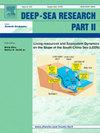波斯湾微型浮游植物的功能群动力学和环境强迫:来自哈尔克和格什姆群岛的时间模式
IF 3
3区 地球科学
Q2 OCEANOGRAPHY
Deep-sea Research Part Ii-topical Studies in Oceanography
Pub Date : 2025-08-18
DOI:10.1016/j.dsr2.2025.105534
引用次数: 0
摘要
浮游植物群落在海洋生态系统恢复力和生物地球化学循环中发挥着至关重要的作用,但在波斯湾等极端环境条件下,它们对环境波动的功能响应仍然知之甚少。本研究调查了波斯湾哈尔克岛和格什姆岛周围浮游植物群落在一个年度周期(2021年11月至2022年12月)的时空结构,将分类多样性与基于性状的功能方法结合起来,评估不同物理化学条件下的适应策略。每月在6个站点(每个岛屿3个)取样,并根据光合色素组成、生长形式、体型、能动性、固氮能力、营养策略、细胞壁组成、长投影和垂直迁移等9个关键性状对浮游植物的功能多样性进行量化。结果揭示了两个岛屿之间不同的生态制度。Qeshm岛浮游植物群落分类多样,功能稳定,反映了相对恒定环境条件下的生态稳定性。相比之下,哈尔克浮游植物群落在功能多样性上表现出明显的季节性变化,这种变化受盐度、碳酸盐化学和养分有效性的波动影响。聚类分析确定了6个功能基团,其中有两个优势组合:第6组(Trichodesmium erythraeum,一种重氮营养蓝藻)和第4组(Chaetoceros spp.等链状硅藻)。通过典型对应分析(Canonical Correspondence Analysis, CCA)和四角分析(Fourth-Corner Analysis)发现,碳酸盐饱和状态、硝酸盐有效性和温度是影响群落分类和功能组成的关键环境因素。此外,在夏季和初秋期间,Khark的大规模赤色菌繁殖显著改变了碳酸盐系统平衡,这是对波斯湾浮游植物性状-环境关系的新见解,突出了重氮营养蓝藻通过固氮、pH调节和碳酸盐饱和状态的变化驱动生物地球化学反馈回路的能力,并对区域碳循环具有潜在影响。本文章由计算机程序翻译,如有差异,请以英文原文为准。
Functional group dynamics and environmental forcing of microphytoplankton in the Persian Gulf: Temporal patterns from Khark and Qeshm Islands
Phytoplankton communities play a crucial role in marine ecosystem resilience and biogeochemical cycling, yet their functional responses to environmental fluctuations in extreme environmental conditions like the Persian Gulf remain poorly understood. This study investigates the temporal and spatial structuring of microphytoplankton communities around Khark and Qeshm Islands in the Persian Gulf over an annual cycle (November 2021 to December 2022), integrating taxonomic diversity with a trait-based functional approach to assess adaptive strategies under varying physicochemical conditions. Monthly sampling was conducted at six stations (three per island), and phytoplankton functional diversity was quantified based on nine key traits: photosynthetic pigment composition, growth form, body size, motility, nitrogen-fixing ability, trophic strategy, cell wall composition, long projections, and vertical migration. The results reveal distinct ecological regimes between the two islands. The phytoplankton communities in Qeshm Island are taxonomically diverse but functionally stable, reflecting ecological stability under relatively constant environmental conditions. In contrast, the Khark phytoplankton communities exhibit pronounced seasonal shifts in functional diversity shaped by fluctuations in salinity, carbonate chemistry, and nutrient availability. Clustering analysis identified six functional groups with two dominant assemblages: Group 6 (Trichodesmium erythraeum, a diazotrophic cyanobacterium) and Group 4 (chain-forming diatoms such as Chaetoceros spp.). Carbonate saturation state, nitrate availability, and temperature were identified as key environmental factors shaping both taxonomic and functional community composition (as indicated by Canonical Correspondence Analysis (CCA) and Fourth-Corner Analysis). Furthermore, large-scale Trichodesmium erythraeum blooms in Khark during summer and early autumn significantly altered carbonate system equilibrium, a novel insight into phytoplankton trait-environment relationships in the Persian Gulf, highlighting the capacity of diazotrophic cyanobacteria to drive biogeochemical feedback loops through nitrogen fixation, pH modulation, and shifts in carbonate saturation state, with potential implications for regional carbon cycling.
求助全文
通过发布文献求助,成功后即可免费获取论文全文。
去求助
来源期刊
CiteScore
6.40
自引率
16.70%
发文量
115
审稿时长
3 months
期刊介绍:
Deep-Sea Research Part II: Topical Studies in Oceanography publishes topical issues from the many international and interdisciplinary projects which are undertaken in oceanography. Besides these special issues from projects, the journal publishes collections of papers presented at conferences. The special issues regularly have electronic annexes of non-text material (numerical data, images, images, video, etc.) which are published with the special issues in ScienceDirect. Deep-Sea Research Part II was split off as a separate journal devoted to topical issues in 1993. Its companion journal Deep-Sea Research Part I: Oceanographic Research Papers, publishes the regular research papers in this area.

 求助内容:
求助内容: 应助结果提醒方式:
应助结果提醒方式:


